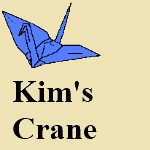No products
Product successfully added to your shopping cart
There are 0 items in your cart. There is 1 item in your cart.
Categories
-
Origami Papers
- Origami Plain Papers
- Origami Papers with Prints
- Origami Double-Sided Papers
- Origami Foil Papers
- Origami Kits
- Other Origami Papers
- Teacher's Corner - Bulk Origami
- Lucky Star Paper
- Discontinued Items
- Japanese Crepe Paper - Double Sided
- 3D or Modular Block Origami
- Papers For Chigiri-e
- Paper End Cuts
- Not Discounted
- Origami Books
- Artisan or Decorative Papers
- Accent Decor
- Elephant Hide
- Origami Related Products
- Mulberry Or Unryu Paper
- Glassine paper (translucent paper) 100% sulphite, acid free, machine made.
- Kraft Paper
- Miscellaneous Items
- Glitter Pearlized Paper
Top sellers
-

Elephant Hide Paper by Zanders - White Color
Elephant Hide Paper by Zanders is scratch proof and scuff proof, with...
$6.60 -

Origami Paper Blue Same Color Bothside - 150 mm - 30 sheets
One color per package - blue, same color on both sides of the paper. 30...
$2.60 -

Crane Egg Folding Paper
$0.48 -

Elephant Hide Paper by Zanders - Charcoal Color
Elephant Hide Paper by Zanders is scratch proof and scuff proof, with...
$6.60
New products
-

Origami Paper Double Sided Hana Print - 150 mm - 32 sheets
There are 32 sheets total; eight sheets each of the four color prints of...
$2.53 -

Pearl Pastel Origami Paper - 18 sheets - 150mm
There are 18 sheets total, six different pearl pastel colors, reverse...
$1.40 -

Cute Print Origami Paper - 150mm -14 sheets
There are 14 sheets total, four different colors of then same cute...
$1.50 -

Yuzen Washi Chiyogami Print - 5 Prints - 150mm
There are five sheets total, each sheet is a different prints of yuzen...
$4.99
ORIGAMI DISCOVERS CHIYOGAMI PAPER
Chiyogami is a type of Japanese paper decorated with brightly colored, woodblock-printed patterns. Used today for a variety of handicrafts, such as covering small boxes, origami, and making kimono for paper dolls (anesama). Ukiyo-e artists first produced Chiyogami in the late 18th century. The word is a combination of chiyo (literally, "a thousand generations") and kami (gami), or paper, and has auspicious connotations similar to those evoked by the pine, bamboo, and plum-blossom motifs with which it is often printed. Pine and bamboo trees remain green throughout the coldest weather, while winter-flowering plum trees bloom even when their branches are decked with snow, thus giving hope to mankind during the bleakest season of the year. Combinations of cranes and tortoises are popular, because these animals have always served as emblems of long life and happiness.
As anesama began to flourish at a time when ornamental paper was increasingly regarded as a necessity; in return, the influence of anesama upon chiyogami became apparent. One direct result was the enormous number of miniature adaptations from standard all-over fabric patterns, such as stripes, laids, dots, or other geometric designs, and floral scatter prints. The origami folder of today need only walk into a modern fabric store and glance around at all the wonderful fabric patterns and think of how the patterns would look on a piece of paper. Perhaps this accounts for a small part in the growing popularity of fabrigami.
During the Edo period (1603-1867), chiyogami was an outcome of the many established papermaking centers throughout Japan. It was the paper of choice by many who could not afford the beautiful washi papers. Like washi paper, its popularity spread from Kyoto, to Edo (modern Tokyo), and Osaka. It is from these three main cities that it is still being manufactured and sold by a handful of woodblock printers.
For the origamist of today, chiyogami has caught the attention of the prospective folder who does not want to pay a hefty price for attractive and foldable paper. Like in times past, chiyogami continues to remain the choice for the origami folder when compared to its rich cousin - washi paper.
This article has been authored by Kimberly Crane. All rights reserved, please contact Kimberly Crane for authorization to copy material in this article.



